Who was and is the first female harbor pilot in Florida?
You would know the answer if you attended the TBOWIT March 2016 luncheon.
It’s none other than Captain Carolyn Kurtz!
To celebrate Women’s History Month we asked Capt. Kurtz to come and tell us her story. It was a great way to celebrate Capt. Kurtz and women’s history month, but in the end it was the audience who benefited as we learned A LOT about Capt. Kurtz, about being a harbor pilot, and about Port Tampa Bay.
Not only was Capt. Kurtz the first female to pass the pilot test in Florida, but she was only the eighth female in the entire U.S. In present time, there are about 1,200 pilots and only 30 are women, but there are more females entering maritime schools.
What does a harbor pilot do?
A harbor pilot takes charge of a large ocean going vessel close to a port and brings the vessel safe to berth and vice versa. These vessels are longer than a skyscraper!
How does a pilot get onboard?
A pilot gets a boat ride to the vessel, a rope ladder is dropped, the pilot climbs the ladder and voilà – the pilot is on board. Sounds simple, but with waves and wind, it can be tricky!
What is a typical work schedule?
2 weeks on (24/7) & 2 weeks off
Capt. Kurtz during part of her presentation showed a really cool slide deck of pictures that were taken of a few recent jobs. It was impressive!
As Capt. Kurtz explained in the maritime industry, the pay is equal and the job of a pilot is a lone pursuit. Any failure or success is attributed to the licensed person and not on anyone’s gender. Of the thousands of jobs that she has had only a handful have been negative experiences most of which were due to ignorance and confusion and were not mean or malicious. In anything, the crew members are curious and make for interesting encounters.
Of course we want to hear one of these negative stories! Actually, the story can be entitle Success is the Best Revenge. Early in Capt. Kurtz’s career when she was a chiefmate, she received some pushback from a captain. Eventually, she left that company. Years later when Capt. Kurtz was a harbor pilot here in Tampa, she got the job to bring in a vessel for this same captain. The captain’s face could not register the fact that Capt. Kurtz brought in his vessel safely, called out the speeds, knew where that vessel was at every moment in that channel, and made a text book perfect docking. That captain had to give Capt. Kurtz her due!
Another funny story, had to do with the time Capt. Kurtz piloted a disabled vessel that had had an engine fire and there was no operable toilet. That’s a story you have to hear in person so you can laugh along.
Capt. Kurtz has a long bio which I will past below. Just know that Capt. Kurtz is the real deal. If you ever get the chance to shake her hand – do it!
(picture - Capt. Kurtz bottom left with the TBOWIT Board)

Bio
Captain Carolyn Kurtz is one of the few pilots working for the Tampa Bay Pilots Association. Originally from New York, Captain Kurtz graduated from the U.S. Merchant Marine Academy in 1986. She immediately joined Maritime Overseas Corporation as third officer, obtained an unlimited master’s license in 1993 and sailed until 1994. In 1995, she became the first woman to enter the training program to become a harbor pilot in the State of Florida. She graduated in the class of 1986 with only 10 percent female, which helped prepare her to be the sole woman during months at sea, including the Persian Gulf in 1987-88 during the Iran-Iraq War.
The Homeland Security Department acknowledged her skill with an appointment to its Navigation Safety Advisory Council, made up of civilian maritime professionals. Captain Kurtz has previously served as an FHPA director and was co-manager of the Tampa Bay Pilots Association from 2007-2009. She has been recognized as a “Woman of Distinction” by the Girl Scouts; and in 2010, received the “Breaking the Glass Ceiling” Award from the Jewish Museum of Florida. She is also a guest instructor at MITAGS and Maritime Pilots Institute. In 2012 she was the recipient of the Tampa Bay OWIT's Person of the Year.


